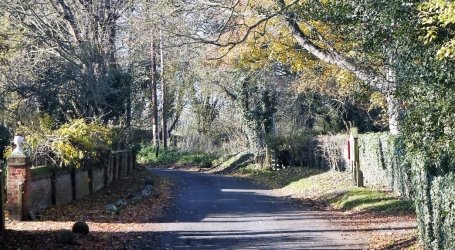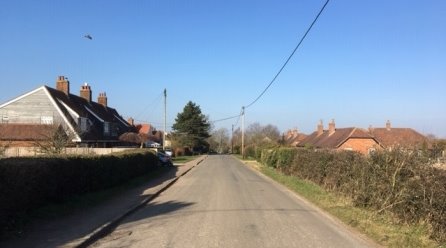Baldock, Bygrave & Clothall Neighbourhood Plan - Submission Version
Policies for the villages
Development within or immediately adjoining Upper or Lower Bygrave should:
- be limited to those forms of development identified as not inappropriate in the Green Belt in the National Planning Policy Framework, including limited affordable housing on a rural exception site to meet an identified need in the local community;
- preserve the physical and visual separation between the two parts of the village;
- maintain the distinctive characters and physical form of Upper and Lower Bygrave (scattered, low density development around St Margaret's Church; modestly-scaled houses set back from the road along Ashwell Road in Upper Bygrave; and the linear arrangement of detached houses set in large plots along Ashwell Road and Wedon Way in Lower Bygrave); and
- not introduce additional lighting that would harm Bygrave's rural character.
Reason for this policy
The village of Bygrave is proposed to be classified as a 'category c' settlement in the new North Hertfordshire Local Plan, and is 'washed over' by the Green Belt. As a result, opportunities for development within or immediately adjoining Bygrave will continue to be very limited. National policy does however allow for replacement buildings and modest extensions, limited affordable housing on a 'rural exception site' to meet an identified local need (where provided for in local planning policies[43]) and facilities for agriculture, outdoor sport and recreation[44].
Any rural exception site proposed for Bygrave would need to be small in size, address a specific identified need for affordable housing in the local community, and ensure that the affordable homes provided remain affordable in perpetuity. Further policy on rural exception sites is set out in policy CGB2a in the new North Hertfordshire Local Plan.
Upper Bygrave (Ashwell Road)
The different architectural characters, arrangements of buildings and physical separation of Upper and Lower Bygrave are distinctive features of the village, and it is important that any development recognises and reflects this. Another important characteristic is Bygrave's rural feel, and in particular the relative absence of light pollution, so new development should also avoid introducing lighting that would be intrusive.
Policy V2 Clothall and Luffenhall
Development within or immediately adjoining Clothall or Luffenhall should:
- in the case of Clothall, be limited to those forms of development identified as not inappropriate in the Green Belt in national planning policy, including limited affordable housing on a rural exception site to meet an identified need in the local community;
- in the case of Luffenhall, be limited to those forms of development allowed by the North Hertfordshire Local Plan (excluding new housing, other than where it involves the conversion or replacement of an existing building); and
- maintain the rural appearance and physical form of these villages, with narrow lanes bordered with trees and hedgerows, a lack of continuous urban frontages, most houses set well back from the road and an absence of footpaths and street lighting.

Clothall village
Reason for this policy
The village of Clothall is, like Bygrave, proposed to be classified as a 'category c' settlement in the new North Hertfordshire Local Plan, and 'washed over' by the Green Belt. This means that opportunities for development within or immediately adjoining Clothall will continue to be very limited, in the same way as they are in Bygrave. National policy does however allow for replacement buildings and modest extensions, limited affordable housing on a 'rural exception site' to meet an identified local need (where provided for in local planning policies[45]) and facilities for agriculture, outdoor sport and recreation[46].
Any rural exception site proposed for Clothall village would need to be small in size, address a specific identified need for affordable housing in the local community, and ensure that the affordable homes provided remain affordable in perpetuity. Further policy on rural exception sites is set out in policy CGB2a in the new North Hertfordshire Local Plan.
Slightly different considerations apply in Luffenhall, which because of its small size is not recognised as a settlement in the new North Hertfordshire Local Plan (or in the saved policies of the existing District Local Plan No.2 With Alterations). It lies in the rural area outside the Green Belt, where both the existing and new Local Plans apply a general policy of restraint. The new Local Plan is, like its predecessor, designed to allow a limited range of development in this area under policies CGB1 and CGB4, similar to the uses that may be permitted in the Green Belt. It includes development relating to an existing building, modest proposals for rural economic development and facilities for agriculture, outdoor sport and recreation.
Policy CGB1 in the new Local Plan also allows development that would meet a proven local need for rural affordable housing or community facilities in the rural area beyond the Green Belt, but only in 'appropriate locations'. Because of its very small size and dispersed form, Luffenhall is not considered to be an appropriate location for new housing, other than where it involves the conversion or replacement of an existing building.
Clothall and Luffenhall share a very rural character and appearance. Their narrow roads, and preponderance of substantial hedgerows and trees, mean that vegetation rather than buildings tends to dominate, and creates a strong sense of enclosure. Their position away from through roads, and relative absence of urban features, add to this rural character, and it is important that this quality is retained where any development does take place. This means that particular care should be taken with the siting and scale of proposals, and with the planting and materials used, especially around site boundaries.
[43] See policies SP2 and CGB2a in the new North Hertfordshire Local Plan.
[44] For a complete list see Ministry of Housing, Communities and Local Government (2019) National Planning Policy Framework. The Framework requires 'very special circumstances' to be demonstrated if development which is inappropriate in the Green Belt is to be approved. While the Framework does allow limited 'infilling' in villages within the Green Belt, Bygrave is not classified as a 'village' for planning purposes in the new North Hertfordshire Local Plan (or in the saved policies of the District Local Plan No.2 With Alterations), so this provision does not apply.
[45] See policies SP2 and CGB2a in the new North Hertfordshire Local Plan.
[46] For a complete list see Department for Communities and Local Government (2019) National Planning Policy Framework. The Framework requires 'very special circumstances' to be demonstrated if development which is inappropriate in the Green Belt is to be approved. While the Framework does allow limited 'infilling' in villages within the Green Belt, Clothall is not classified as a 'village' for planning purposes in the new North Hertfordshire Local Plan (or in the saved policies of the District Local Plan No.2 With Alterations), so this provision does not apply.

